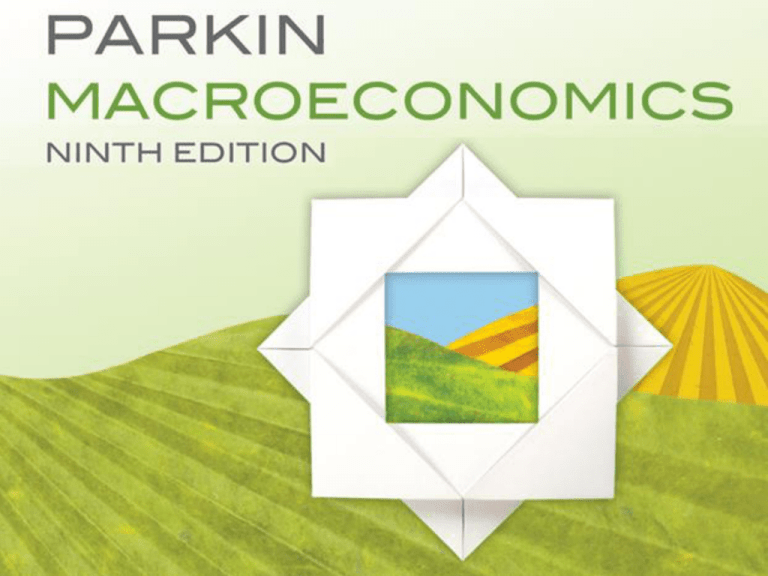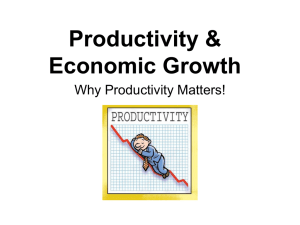
© 2010 Pearson Addison-Wesley
© 2010 Pearson Addison-Wesley
The Basics of Economic Growth
Economic growth is the sustained expansion of production
possibilities measured as the increase in real GDP over a
given period.
Calculating Growth Rates
The economic growth rate is the annual percentage
change of real GDP.
The economic growth rate tells us how rapidly the total
economy is expanding.
© 2010 Pearson Addison-Wesley
The Basics of Economic Growth
The standard of living depends on real GDP per person.
Real GDP per person is real GDP divided by the
population.
Real GDP per person grows only if real GDP grows faster
than the population grows.
© 2010 Pearson Addison-Wesley
The Basics of Economic Growth
The Magic of Sustained Growth
The Rule of 70 states that the number of years it takes for
the level of a variable to double is approximately 70 divided
by the annual percentage growth rate of the variable.
© 2010 Pearson Addison-Wesley
The Basics of Economic Growth
Applying the Rule of 70
Figure 6.1 show the
doubling time for growth
rates.
A variable that grows at
7 percent a year doubles
in 10 years.
A variable that grows at
2 percent a year doubles
in 35 years.
A variable that grows at
1 percent a year doubles
in 70 years.
© 2010 Pearson Addison-Wesley
Economic Growth Trends
Growth in the U.S. Economy
From 1908 to 2008, growth in real GDP per person in the
United States averaged 2 percent a year.
Real GDP per person fell precipitously during the Great
Depression and rose rapidly during World War II.
Growth was most rapid during the 1960s.
Growth slowed during the 1970s and sped up again in the
1980s and1990s.
Figure 6.2 on the next slide illustrates.
© 2010 Pearson Addison-Wesley
Economic Growth Trends
© 2010 Pearson Addison-Wesley
Economic Growth Trends
Real GDP Growth in the
World Economy
Figure 6.3(a) shows the
growth in the rich
countries.
Growth in the United
States, Canada, and
Europe Big 4 has been
similar.
Japan grew rapidly in
the 1960s, slower in the
1980s, and even slower
in the 1990s.
© 2010 Pearson Addison-Wesley
Economic Growth Trends
Figure 6.3(b) shows
the growth of real GDP
per person in group of
poor countries.
The gaps between real
GDP per person in the
United States and in
these countries have
widened.
© 2010 Pearson Addison-Wesley
How Potential GDP Grows
Economic growth occurs when real GDP increases.
But a one-shot increase in real GDP or a recovery from
recession is not economic growth.
Economic growth is the sustained, year-on-year increase
in potential GDP.
© 2010 Pearson Addison-Wesley
How Potential GDP Grows
How Potential GDP Is Determined
Potential GDP is the quantity of real GDP produced when
the quantity of labor employed is the full-employment
quantity.
To determine potential GDP we use a model with two
components:
The
aggregate production function
The
aggregate labor market
© 2010 Pearson Addison-Wesley
How Potential GDP Grows
Aggregate Production
Function
The aggregate production
function tells us how real
GDP changes as the
quantity of labor changes
when all other influences
on production remain the
same.
An increase in labor
increases real GDP.
© 2010 Pearson Addison-Wesley
How Potential GDP Grows
Aggregate Labor Market
The real wage rate is the money wage rate divided
by the price level.
The demand for labor shows the quantity of labor
demanded and the real wage rate.
The supply of labor shows the quantity of labor
supplied and the real wage rate.
The labor market is in equilibrium at the real wage
rate at which the quantity of labor demanded equals
the quantity of labor supplied.
© 2010 Pearson Addison-Wesley
How Potential GDP Grows
Figure 6.5 illustrates labor
market equilibrium.
Labor market equilibrium
occurs at a real wage rate
of $35 an hour and 200
billion hours employed.
At a real wage rate above
$35 an hour, there is a
surplus of labor and the
real wage rate falls.
© 2010 Pearson Addison-Wesley
How Potential GDP Grows
At a real wage rate below
$35 an hour, there is a
shortage of labor and the
real wage rate rises.
At the labor market
equilibrium, the economy
is at full employment.
© 2010 Pearson Addison-Wesley
How Potential GDP …
Potential GDP
The quantity of real GDP
produced when the economy
is at full employment is
potential GDP.
When the full-employment
quantity of labor is 200 billion
hours, potential GDP is $12
trillion.
© 2010 Pearson Addison-Wesley
How Potential GDP Grows
What Makes Potential GDP Grow?
We begin by dividing real GDP growth into the forces that
increase:
Growth in the supply of labor
Growth in labor productivity
© 2010 Pearson Addison-Wesley
How Potential GDP Grows
Growth in the Supply of Labor
Aggregate hours, the total number of hours worked by all
the people employed, change as a result of changes in:
1. Average hours per worker
2. Employment-to-population ratio
3. The working-age population growth
Population growth increases aggregate hours and real
GDP, but to increase real GDP person, labor must become
more productive.
© 2010 Pearson Addison-Wesley
How Potential GDP Grows
The Effects of Population Growth
An increase in population increases the supply of labor.
With no change in the demand for labor, the equilibrium
real wage rate falls and the aggregate hours increase.
The increase in the aggregate hours increases potential
GDP.
© 2010 Pearson Addison-Wesley
How Potential GDP Grows
Figure 6.7(a) illustrates the
effects of population
growth in the labor market.
The labor supply curve
shifts rightward.
The real wage rate falls
and aggregate hours
increase.
© 2010 Pearson Addison-Wesley
How Potential GDP Grows
The increase in aggregate
hours increases potential
GDP.
Because the diminishing
returns, the increased
population increases real
GDP but decreases real
GDP per hour of labor.
© 2010 Pearson Addison-Wesley
How Potential GDP Grows
Growth in Labor Productivity
Labor productivity is the quantity of real GDP produced
by an hour of labor.
Labor productivity equals real GDP divided by aggregate
labor hours.
If labor become more productive, firms are willing to pay
more for a given number of hours so the demand for labor
increases.
© 2010 Pearson Addison-Wesley
How Potential GDP Grows
Figure 6.8 shows the effect
of an increase in labor
productivity.
The increase in labor
productivity shifts the
production function
upward.
© 2010 Pearson Addison-Wesley
How Potential GDP Grows
In the labor market:
An increase in labor
productivity increases the
demand for labor.
With no change in the
supply of labor, the real
wage rate rises
and aggregate hours
increase.
© 2010 Pearson Addison-Wesley
How Potential GDP Grows
And with the increase in
aggregate hours, potential
GDP increases.
© 2010 Pearson Addison-Wesley
Why Labor Productivity Grows
Preconditions for Labor Productivity Growth
The fundamental precondition for labor productivity growth
is the incentive system created by firms, markets, property
rights, and money.
The growth of labor productivity depends on
Physical capital growth
Human capital growth
Technological advances
© 2010 Pearson Addison-Wesley
Why Labor Productivity Grows
Physical Capital Growth
The accumulation of new capital increases capital per
worker and increases labor productivity.
Human Capital Growth
Human capital acquired through education, on-the-job
training, and learning-by-doing is the most fundamental
source of labor productivity growth.
© 2010 Pearson Addison-Wesley
Why Labor Productivity Grows
Technological Advances
Technological change—the discovery and the application
of new technologies and new goods—has contributed
immensely to increasing labor productivity.
Figure 6.9 on the next slide summarizes the process of
growth.
It also shows that the growth of real GDP per person
depends on real GDP growth and the population growth
rate.
© 2010 Pearson Addison-Wesley
Why Labor Productivity Grows
© 2010 Pearson Addison-Wesley
Why Labor Productivity Grows
The quantity of real GDP produced, Y, depends on the
quantity of labor, L, the quantity of capital, K, and the state
of technology, T.
Growth accounting calculates the contribution of capital
growth and technological change to labor productivity
growth.
Robert Solow estimated the effects of capital on labor
productivity and discovered the one third rule.
© 2010 Pearson Addison-Wesley
Why Labor Productivity Grows
The one-third rule: On average with no change in
technology, a 1 percent increase in capital per hour of
labor brings a 1/3 percent increase in labor productivity.
For example, suppose capital per hour of labor grows by 3
percent and labor productivity grows by 2.5 percent.
The one third rule tells us that capital growth contributed
1/3 of 3 percent, which is 1 percent, to labor productivity
growth.
The remaining 1.5 percent of labor productivity growth
comes from technological change.
© 2010 Pearson Addison-Wesley
Why Labor Productivity Grows
Accounting for the Productivity Growth Slowdown and
Speedup
We can use the one third rule to study productivity growth
in the United States.
Figure 6.10 on the next slide illustrates.
© 2010 Pearson Addison-Wesley
Why Labor Productivity Grows
Part (a) shows the growth of
U.S. labor productivity.
Between 1960 and 1973,
labor productivity grew by
3.7 percent a year.
Part (b) shows that capital
growth (green bar) and
technological change
(purple bar) contributed
equally to this growth.
© 2010 Pearson Addison-Wesley
Why Labor Productivity Grows
Between 1973 and 1983,
labor productivity slowed
to 1.7 percent a year.
A collapse in the
contribution of
technological change
(purple bar) brought about
this slowdown in the
growth of labor
productivity.
© 2010 Pearson Addison-Wesley
Why Labor Productivity Grows
Labor productivity growth
rate increased …
to 2 percent a year
between 1983 and 1993
and …
to almost 3 percent
between 1993 and 2008.
Technological change
contributed most to this
speedup in the growth of
labor productivity.
© 2010 Pearson Addison-Wesley
Growth Theories and Policies
We study three growth theories:
Classical growth theory
Neoclassical growth theory
New growth theory
Classical Growth Theory
Classical growth theory is the view that the growth of
real GDP per person is temporary and that when it rises
above the subsistence level, a population explosion
eventually brings real GDP per person back to the
subsistence level.
© 2010 Pearson Addison-Wesley
Growth Theories and Policies
Classical Theory of Population Growth
There is a subsistence real wage rate, which is the
minimum real wage rate needed to maintain life.
Advances in technology lead to investment in new capital.
Labor productivity increases and the real wage rate rises
above the subsistence level.
When the real wage rate is above the subsistence level,
the population grows.
Population growth increases the supply of labor and brings
diminishing returns to labor.
© 2010 Pearson Addison-Wesley
Growth Theories and Policies
As the population increases the real wage rate falls.
The population continues to grow until the real wage rate
has been driven back to the subsistence real wage rate.
At this real wage rate, both population growth and
economic growth stop.
Contrary to the assumption of the classical theory, the
historical evidence is that population growth rate is not
tightly linked to income per person, and population growth
does not drive incomes back down to subsistence levels.
© 2010 Pearson Addison-Wesley
Growth Theories and Policies
Neoclassical Growth Theory
Neoclassical growth theory is the proposition that real
GDP per person grows because technological change
induces a level of saving and investment that makes
capital per hour of labor grow.
Growth ends only if technological change stops.
© 2010 Pearson Addison-Wesley
Growth Theories and Policies
The Neoclassical Economics of Population Growth
The neoclassical view is that the population growth rate is
independent of real GDP and the real GDP growth rate.
Technological Change
In the neoclassical theory, the rate of technological change
influences the economic growth rate but economic growth
does not influence the pace of technological change.
It is assumed that technological change results from
chance.
© 2010 Pearson Addison-Wesley
Growth Theories and Policies
The Basic Neoclassical Idea
Technology begins to advance more rapidly.
New profit opportunities arise.
Investment and saving increase.
As technology advances and the capital stock grows, real
GDP per person rises.
Diminishing returns to capital lower the real interest rate
and eventually growth stops, unless technology keeps on
advancing.
© 2010 Pearson Addison-Wesley
Growth Theories and Policies
A Problem with Neoclassical Growth Theory
All economies have access to the saamew technologies
and capital is free to roam the globe, seeking the highest
available real interest rate.
These facts imply that economic growth rates and real
GDP per person across economies will converge.
Figure 6.3 shows some convergence among rich
countries, but convergence is slow.
© 2010 Pearson Addison-Wesley
Growth Theories and Policies
New Growth Theory
New growth theory holds that real GDP per person grows
because of choices that people make in the pursuit of
profit and that growth can persist indefinitely.
The theory begins with two facts about market economies:
Discoveries result from choices.
Discoveries bring profit and competition destroys profit.
© 2010 Pearson Addison-Wesley
Growth Theories and Policies
Two further facts play a key role in the new growth theory:
Discoveries are a public capital good.
Knowledge is not subject to diminishing returns.
Knowledge Capital Is Not Subject to Diminishing
Returns
Increasing the stock of knowledge makes capital and labor
more productive.
Knowledge capital does not experience diminishing
returns is the central proposition of new growth theory.
© 2010 Pearson Addison-Wesley
Growth Theories and Policies
Figure 6.11
summarizes
the ideas of
new growth
theory as a
perpetual
motion
machine.
© 2010 Pearson Addison-Wesley
Growth Theories and Policies
Achieving Faster Growth
Growth accounting tell us that to achieve faster economic
growth we must either increase the growth rate of capital
per hour of labor or increase the pace of technological
change.
The main suggestions for achieving these objectives are
Stimulate Saving
Saving finances investment. So higher saving rates might
increase physical capital growth.
Tax incentives might be provided to boost saving.
© 2010 Pearson Addison-Wesley
Growth Theories and Policies
Stimulate Research and Development
Because the fruits of basic research and development
efforts can be used by everyone, not all the benefit of a
discovery falls to the initial discoverer.
So the market might allocate too few resources to
research and development.
Government subsidies and direct funding might stimulate
basic research and development.
© 2010 Pearson Addison-Wesley
Growth Theories and Policies
Encourage International Trade
Free international trade stimulates growth by extracting all
the available gains from specialization and trade.
The fastest growing nations are the ones with the fastest
growing exports and imports.
Improve the Quality of Education
The benefits from education spread beyond the person
being educated, so there is a tendency to under invest in
education.
© 2010 Pearson Addison-Wesley







